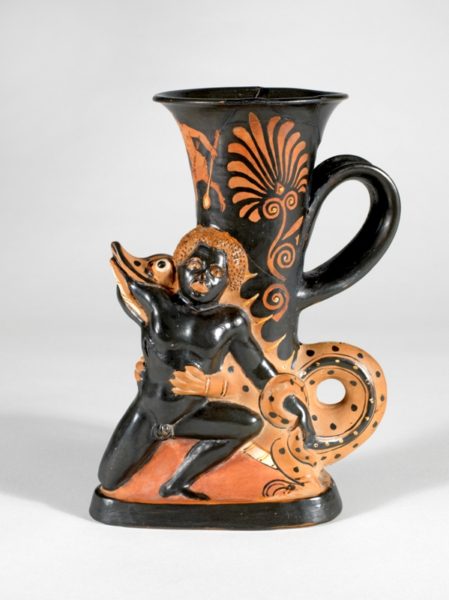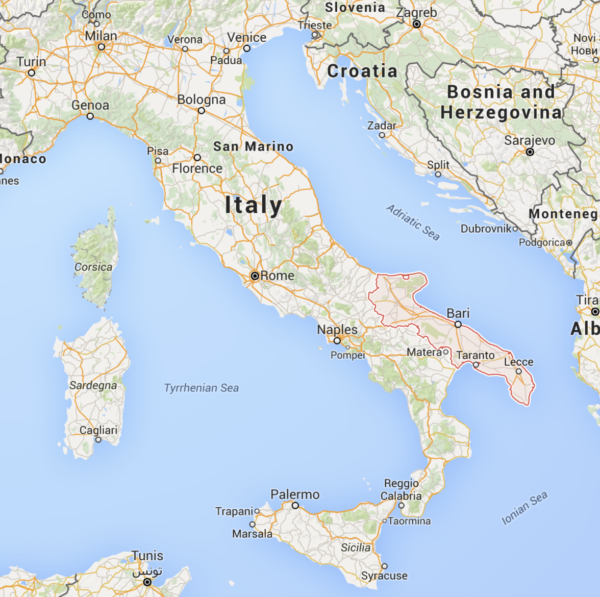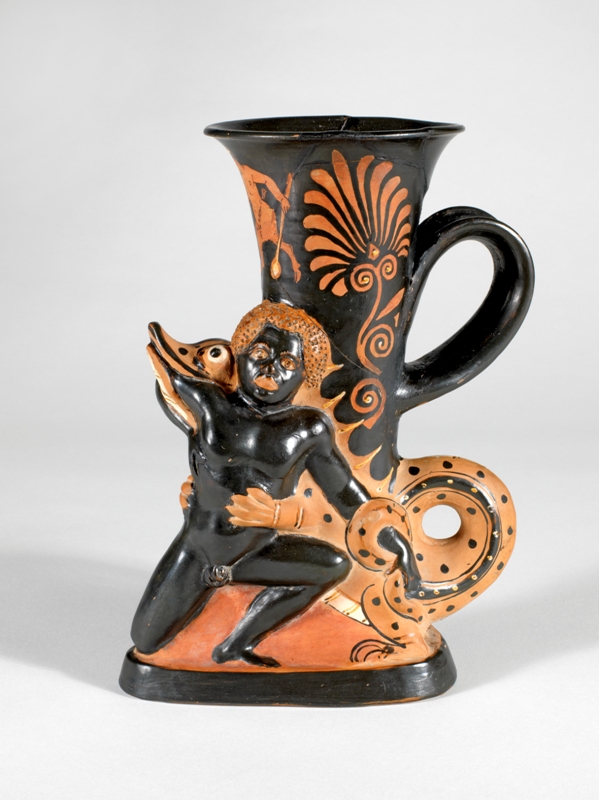How the Greeks depicted the people of Kemet


For the ancient Greeks and Romans their contemporaries in Egypt were different. This is evidenced through descriptions of people from Kemet and also how both Greek and Roman artists depicted people from Africa. The rhyton above is a case in point. This drinking cup was manufactured in the Italian region of Apulia (below highlighted in red), which was home to colonies of Greek people.

The cup above shows a figure of a man, who by the colour of his skin and hair can be identified as being of indigenous African descent, who is being attacked by an animal. The scales on the back of the beast, its tail and its snout identify it as a crocodile; although it would appear as often seems to have been the case that the artist had never actually seen a crocodile but was perhaps basing the representation on descriptions or other works of art. What is remarkable about this particular crocodile is that it wears anklets. This is perhaps a practice that was referenced in a passage in Herodotus’ Histories:
For some of the Egyptians the crocodiles are sacred animals, and for others not so, but they treat them on the contrary as enemies: those however who dwell about Thebes and about the lake of Moiris hold them to be most sacred, and each of these two peoples keeps one crocodile selected from the whole number, which has been trained to tameness, and they put hanging ornaments of molten stone and of gold into the ears of these and anklets round the front feet, and they give them food appointed and victims of sacrifices and treat them as well as possible while they live, and after they are dead they bury them in sacred tombs, embalming them: but those who dwell about the city of Elephantine even eat them, not holding them to be sacred. They are called not crocodiles but champsai, and the Ionians gave them the name of crocodile, comparing their form to that of the crocodiles (lizards) which appear in their country in the stone walls.
(Herodotus Histories 2:69)
The crocodile became synonymous with Egypt for Greek and later Roman artists and there are both vases and stone sculptures that depict humans who look very similar to the one illustrated here, accompanied by crocodiles. It is also true if we look at text references to Egypt or Egyptians, that Greek writers saw no real difference between those people from Egypt and those from Ethiopia. In fact the Greek word Aethiops, from which Ethiopian derives, means ‘burnt face‘, presumably because the Greeks who encountered African people saw them as different to themselves.
Many readers will be familiar with another quote from Herodotus (Histories 2:104) that makes reference to the appearance of the people of Kemet having dark skin (melanchroes) and curly (often translated as ‘woolly‘ on account of the word ‘oleos’.
A survey of commentaries on the use of these words and their suggested translations reveals some degree of subjectivity on behalf of many authors. In his 1988 commentary on Herodotus Book 2, Alan Lloyd writes the following about the use of the word melanchroes:
There is no linguistic justification for relating this description to negroes [sic.]*. Melanchroes could denote colour from bronzed to black and negroes [sic.]* are not the only physical type to show curly hair
* this is the term that is used in the commentary, it is not one that I condone or would choose to use.
Once again we find ourselves back to the supposition that every person of African descent has (literally) skin that is black in colour, rather than acknowledging that African peoples have, and are today described as, light skinned, dark skinned, and in the case of the Caribbean red skinned (although this means very light). See an earlier post where I discuss how Egyptologists are keen to differentiate between Egyptian/Kemite and Nubian/Kushite people.
The use of a term to describe the hair that includes the word for wool would suggest that the hair of the ancient Egyptian people was textured and different from that of the Greeks. The reference to dark skin also accords with representations such as the vase above.
The artists’ representations for me speak for themselves. I would not classify myself as a philologist but I did study Ancient Greek for my first degree. The fact that the term melanchroes covers a variety of dark skin colours as pointed out by Lloyd, supports that argument that the people of ancient Kemet were indigenous African people, and that they represented the variance that we find amongst African peoples today.

